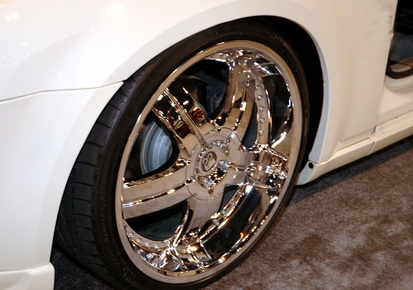
The upper and lower ball joints in your vehicle function as load-bearing swivel joints that keep the wheels in alignment while supporting the vehicle's suspension. Functioning much like a human shoulder joint, they allow for side to side movement and some limited vertical travel. Worn ball joints can misalign the vehicle's front end, cause binding or complete breakage of the suspension. Repairing upper and lower ball joints can be challenging, but the labor time and cost can be greatly reduced for the do-it-yourself repair person with some special techniques and basic tools.
Shift the vehicle into park or neutral and set the emergency brake. Use a tire iron to break the lug nuts loose on both wheels but do not remove the wheels. Use a floor jack to lift the front end of the vehicle high enough to place two jack stands under the frame behind each wheel. Finish removing the lug nuts with the tire iron. Starting on one side of the vehicle, place the floor jack directly under the lower control arm and pump the handle until the suspension compresses.
Locate the upper ball joint. Pull the cotter pin out of the large castellated nut with a pair of pliers. Loosen and remove the large castellated nut with a box-end wrench. Place a pickle fork between the seam of the ball joint and the large swing arm. Strike the ball joint with a hammer until the seam separates. Loosen and remove the two or three ball joint mounting bolts on the upper control arm with a socket.
Lower the floor jack slowly until the ball joint clears the swing arm. Remove the old upper ball joint. Clean the upper control arm and swing arm seat with carburetor cleaner and rags. Place the new upper ball joint onto the swing arm seat and secure the two or three mounting bolts into the base of the ball joint. Tighten the mounting bolts with a socket and wrench. Slowly pump the floor jack handle to raise the lower control arm until the ball joint shaft fits through the upper control arm.
Replace the castellated nut on the top of the ball joint shaft and tighten it down with the socket. Align the nut by turning it with a socket until the shaft hole and nut hole align. Place a new cotter pin into the castellated nut and pull it through with the pliers. Flair the ends of the cotter pin with the wire cutters. Pump up the floor jack until the suspension has been relieved of pressure.
Locate the cotter pin on the lower ball joint's castellated nut. Clip the cotter pin with the wire cutters and pull it out. Use the box-end wrench to remove the castellated nut. Place the pickle fork in the seam between the lower control arm and the swing arm. Strike the pickle fork with the hammer until the seam breaks loose. Locate the mounting bolts for the lower ball joint on the swing arm. Remove them with the socket and wrench. Strike the end shaft of the old ball joint with the hammer to remove it from its seat.
Clean the swing arm and lower control arm ball joint seats with carburetor cleaner and a rag. Place the new ball joint into the lower control arm and attach the mounting bolts. Tighten the bolts with the socket and wrench. Pump the floor jack handle to raise the lower control arm so the new ball joint goes through the swing arm. Place the castellated nut onto the ball joint shaft and tighten it down with the socket and wrench.
Align the hole in the lower ball joint shaft with the hole in the castellated nut by turning the nut with the box-end wrench. Place a new cotter pin into the nut and flair the cotter pin ends with the wire cutters. Use a hand-pump grease gun to fill both Zerk fittings on the upper and lower ball joint boots with grease. Fill the boots until they expand to full dimension.
Lower the floor jack and move it to the other side of the vehicle, directly under the lower control arm. Repeat the above removal and replacement procedure for the upper and lower ball joints. When finished, mount the rims back onto the wheel hubs and tighten all the lug nuts with the tire iron. Use the floor jack to lift the frame and remove the jack stands. Finish tightening all of the lugs with a torque wrench to specifications.